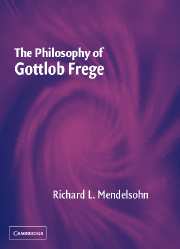Book contents
- Frontmatter
- Contents
- List of Principles
- Preface
- 1 Biography
- 2 Function and Argument
- 3 Sense and Reference
- 4 Frege's Begriffsschrift Theory of Identity
- 5 Concept and Object
- 6 Names and Descriptions
- 7 Existence
- 8 Thought, Truth Value, and Assertion
- 9 Indirect Reference
- 10 Through the Quotation Marks
- Appendix A Begriffsschrift in Modern Notation: (1) to (51)
- Appendix B Begriffsschrift in Modern Notation: (52) to (68)
- Notes
- Bibliography
- Index
8 - Thought, Truth Value, and Assertion
Published online by Cambridge University Press: 28 July 2009
- Frontmatter
- Contents
- List of Principles
- Preface
- 1 Biography
- 2 Function and Argument
- 3 Sense and Reference
- 4 Frege's Begriffsschrift Theory of Identity
- 5 Concept and Object
- 6 Names and Descriptions
- 7 Existence
- 8 Thought, Truth Value, and Assertion
- 9 Indirect Reference
- 10 Through the Quotation Marks
- Appendix A Begriffsschrift in Modern Notation: (1) to (51)
- Appendix B Begriffsschrift in Modern Notation: (52) to (68)
- Notes
- Bibliography
- Index
Summary
Introduction
We saw in Chapter 4 that Frege had applied the Begriffsschrift surrogate for identity, identity of content, to sentences as well as to names. Frege (1879) believed that names and sentences both stood for their contents. Frege (1892c) saw no need to change his treatment of sentences as names. The issue he addressed was not whether sentences refer, but what they refer to. He sought to correct his early account – as well as related views which take propositions, thoughts, states of affairs, or facts as the items designated by sentences. These items, he now thought, belonged at the level of sense. In a very influential argument, Frege defended the view that the two truth values – true and false, or as Frege preferred, the True and the False – are the only candidates that are functionally related via the Compositionality Principle 2.3.1 to the reference of the parts of the sentence, and which, in turn, are functionally related to the reference of larger constructions in which the sentences are embedded. “If we are dealing with sentences for which the Bedeutung of their component parts is relevant,” Frege (1892c: 158–9) asked, “then what feature except the truth value can be found that belongs to such sentences quite generally and remains unchanged by substitutions of the kind just mentioned?” In this chapter, we will examine carefully his views on truth, and, in particular, raise doubts about the inevitability of this result.
- Type
- Chapter
- Information
- The Philosophy of Gottlob Frege , pp. 125 - 139Publisher: Cambridge University PressPrint publication year: 2005



